energy
Type of resources
Available actions
Topics
Keywords
Contact for the resource
Provided by
Years
Formats
Representation types
Scale 1:
Resolution
-
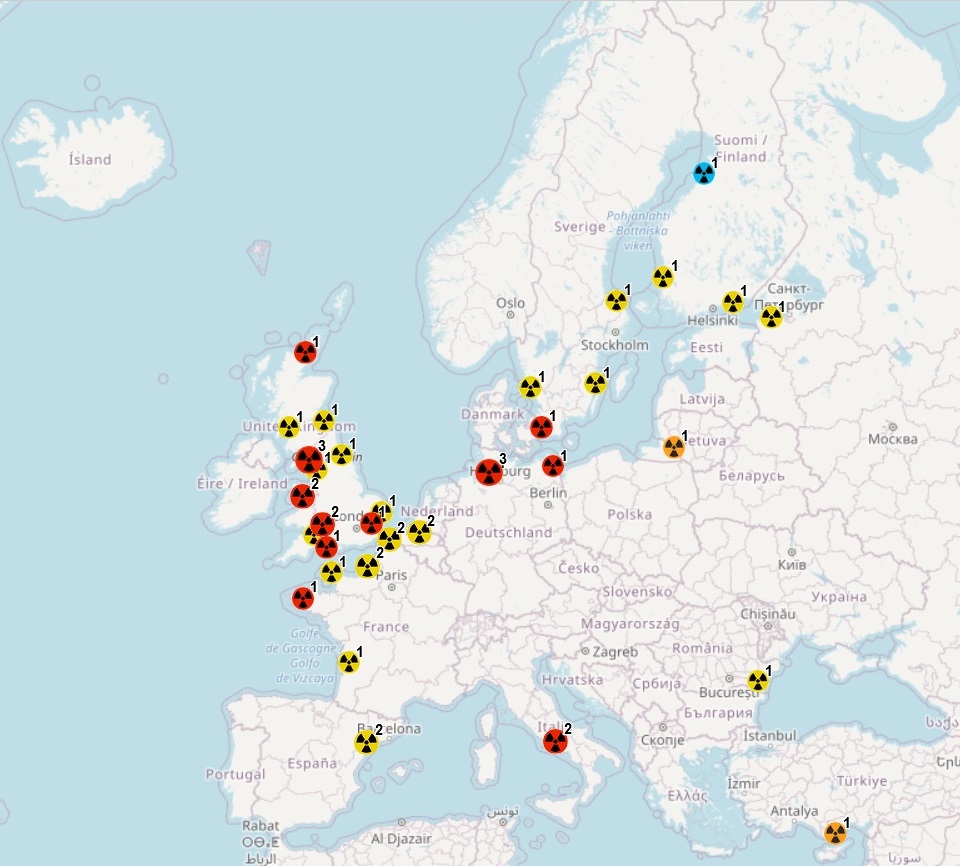
The geodatabase on coastal Nuclear Power Plants was created in 2019 by Cogea for the European Marine Observation and Data Network (EMODnet). It is the result of the aggregation and harmonization of datasets provided by several EU and non-EU sources. It is available for viewing and download on the EMODnet Human Activities web portal (https://emodnet.ec.europa.eu/en/human-activities). The geodatabase contains points representing nuclear power plants sites in the following countries: Belgium, Finland, France, Germany, Italy, Netherlands, Romania, Russia, Spain, Sweden, Turkey and UK. Where available each point has the following attributes: EMODnet Code, Plant Name, Country, Status (Operational, Permanently shut down, Planned, Under construction), Number of Reactors, Thermal Capacity (MW), Gross Capacity (MW), Net Capacity (MW), Location (Municipality), Water Source, Latitude, Longitude. Additional informations about reactors are stored in a separated table and are related to the point feature class. Where available for each reactor the following attributes are reported: EMODnet Code, Plant Name, Status (Operational, Permanently shut down, Planned, Under construction), Type, Model, Fuel Type, Thermal Capacity (MW), Gross Capacity (MW), Net Capacity (MW), Operator, Nuclear Steam Supply System (NSSS), Construction Year, Construction Month, Criticality Year, Criticality Month, Connection to the Grid Year, Connection to the Grid Month, Shut Down Year, Shut Down Month. The dataset will be updated every year.
-
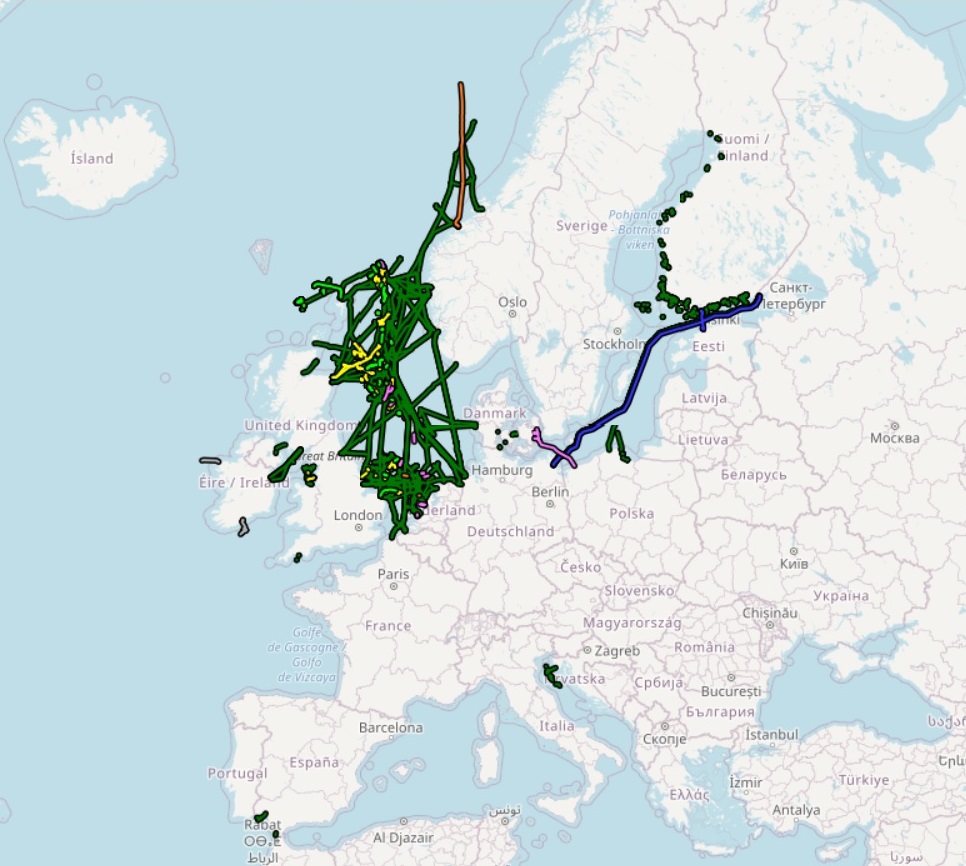
The dataset on offshore pipelines in the European waters was created in 2017 by Cogea for the European Marine Observation and Data Network (EMODnet). It is the result of the aggregation and harmonization of datasets provided by several several EU and non-EU sources. It is updated every year, and is available for viewing and download on the EMODnet web portal (Human Activities, https://emodnet.ec.europa.eu/en/human-activities). The dataset contains lines representing the actual routes of offshore pipelines (where available) in the following countries: Croatia, Denmark, Estonia, Finland, Germany, Ireland, Netherlands, Norway, Poland, Russia, Spain (Andalucía), Sweden and United Kingdom. Each line has the following harmonized attributes (where available): code, name, status (abandoned, active, application submitted, not in use, planned, pre-commissioning, proposed, under construction), medium (air, chemical glycol, chemical methanol, chemical n/a, condensate, control, cooling water, gas, geothermal heating, hydraulic, mixed hydrocarbons, oil, other fluid, sewage, water), operator, size (inches), length (metres), year, from and to locality or facility, country code, country name and notes. Compared with the previous version, this new version includes updated data from German BSH-CONTIS source.
-
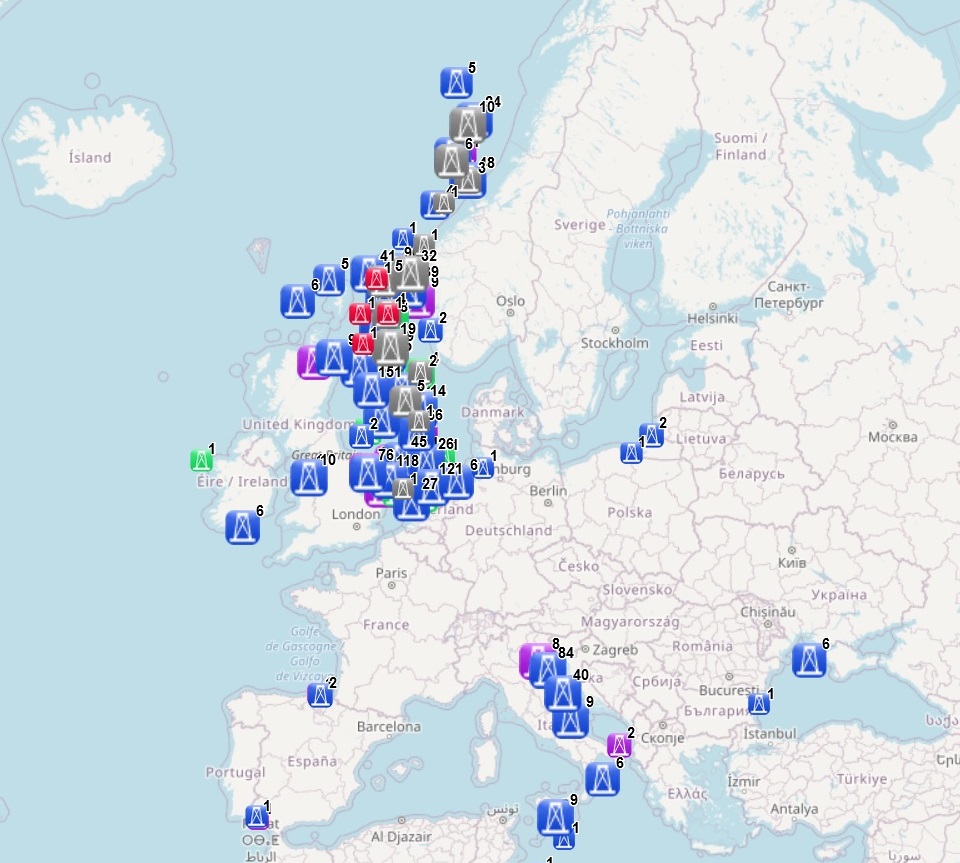
The dataset on offshore installations for Oil and Gas exploitation and exploration activities in the European seas was created in 2015 by Cogea for the European Marine Observation and Data Network (EMODnet). It is the result of the aggregation and harmonization of datasets provided by several EU and non-EU sources. It is updated every year and it is available for viewing and download on EMODnet web portal (Human Activities, https://emodnet.ec.europa.eu/en/human-activities). The dataset contains points representing offshore installations and where available each point has the following attributes: ID, name, country, location block, operator, production start year, primary production, current status, category and function of the installation, sub-structure and topside weights (tonnes), water depth (metres), distance to coast (metres) and notes. The OSPAR commission source covers data for Germany, Ireland, Spain (Atlantic Sea), while for Italy data have been collected and harmonized from the Italian Ministry of Economic Development, for Denmark from the Danish Energy Agency, for the Netherlands from the TNO - Geological Survey of the Netherlands, for Croatia from the Croatian Hydrocarbon Agency, for Norway from the Norwegian Petroleum Directorate, for the UK from the Oil and Gas Authority (surface infrastructures), for Polish and Russian installations in the Baltic Sea from Marine Traffic and Helcom, finally from Marine Traffic come the data for Bulgarian, Russian and Ukrainian installations in the Black Sea and for Spanish installations in the Mediterranean Sea.
-
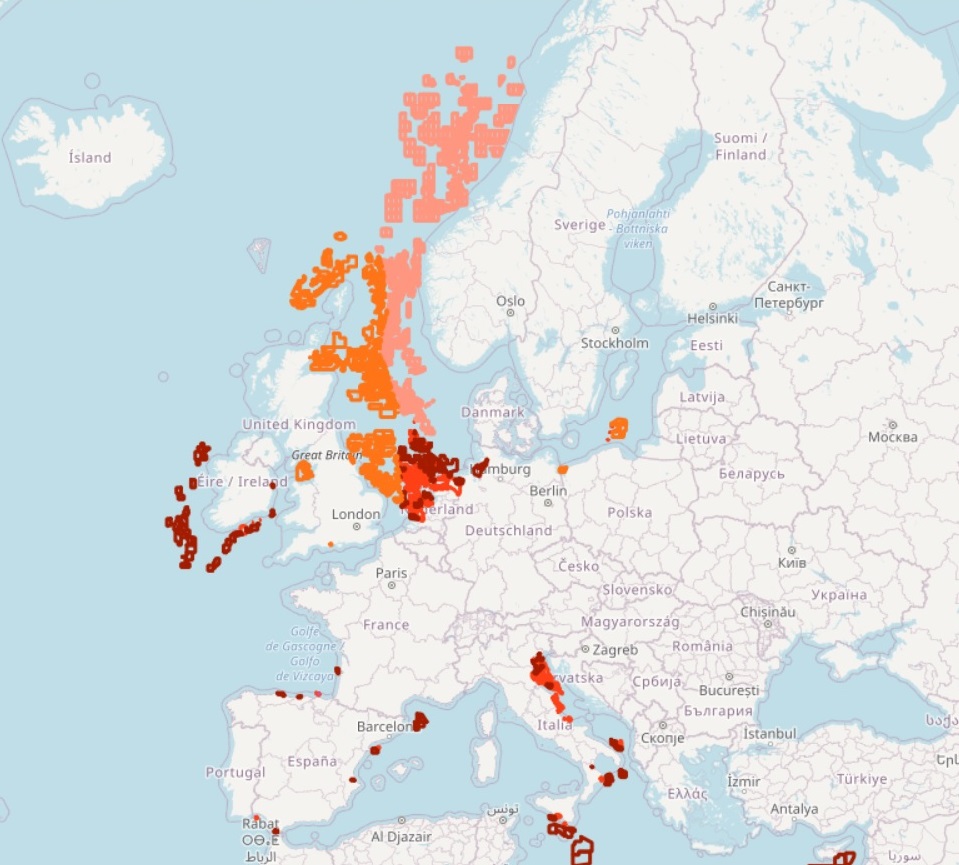
The dataset on offshore active licences for Oil and Gas exploitation and exploration in the EU was created in 2014 by Cogea for the European Marine Observation and Data Network (EMODnet). It is the result of the aggregation and harmonization of datasets provided by several EU and non-EU sources. It is updated every year, and is available for viewing and download on EMODnet Human Activities web portal (https://emodnet.ec.europa.eu/en/human-activities). It contains polygons representing the currently active licences for the following countries: Croatia, Cyprus, Denmark, Germany, Ireland, Italy, Malta, Netherlands, Norway, Poland, Spain and United Kingdom. Where available each polygon has the following attributes: country, code, name, type (exploitation, exploration, exploitation and exploration, other), licensing round (it includes also pending applications in Spain), area (square km), area info (it indicates if the area value is original from the source or has been calculated), valid from, valid to, operator or administrator, notes. Compared with the previous release, Maltese open areas and blocks for hydrocarbon licensing have been updated. Currently there are no active licenced areas in the French and Portuguese waters and no data available in the Black Sea.
-
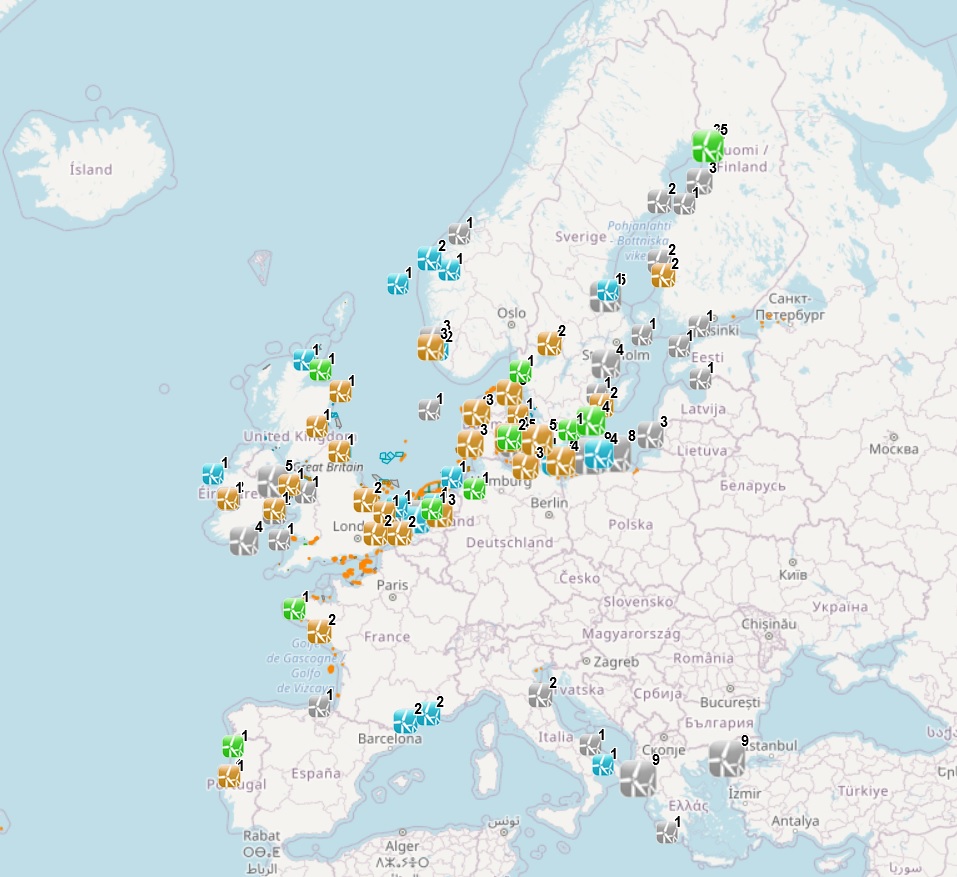
The dataset on offshore wind farms in the European seas was created in 2014 by CETMAR for the European Marine Observation and Data Network (EMODnet). It is the result of the aggregation and harmonization of datasets provided by several sources. It is updated every year and it is available for viewing and download on EMODnet web portal (Human Activities, https://emodnet.ec.europa.eu/en/human-activities). The dataset contains points and/or (where available) polygons representing offshore wind farms in the following countries: Belgium, Denmark, Estonia, Finland, France, Germany, Greece, Ireland, Italy, Latvia, Lithuania, Netherlands, Norway, Poland, Portugal, Spain, Sweden and United Kingdom. Each point and polygon has the following attributes (where available): Name, Nº of turbines, Status (Approved, Planned, Dismantled, Construction, Production, Test site), Country, Year, Power (MW), Distance to coast (metres) and Area (square kilometres). The distance to coast (EEA coastline shapefile) has been calculated using the UTM WGS84 Zone projected coordinate system where data fall in.
-
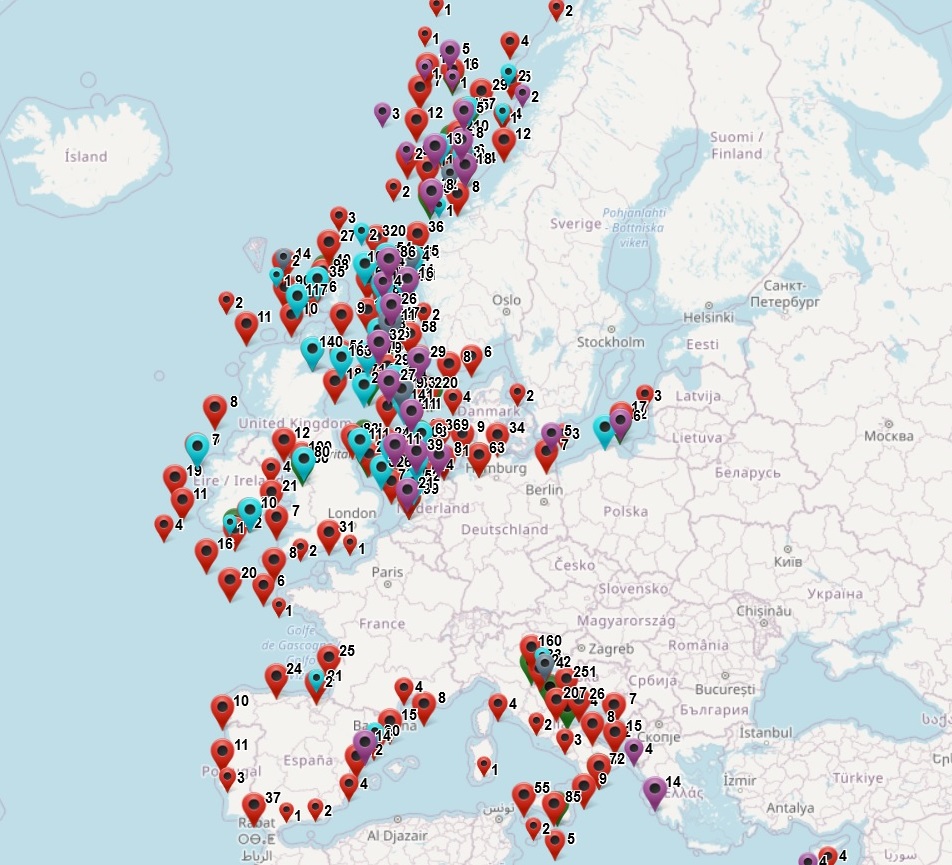
The dataset on offshore wells for Oil and Gas industry activities in the EU was created in 2014 by Cogea for the European Marine Observation and Data Network (EMODnet). It is the result of the aggregation and harmonization of datasets provided by several EU and non-EU sources. It is updated every year, and is available for viewing and download on the EMODnet web portal (Human Activities, https://emodnet.ec.europa.eu/en/human-activities). It contains points representing offshore wells drilled in the following countries: Croatia, Cyprus, Denmark, Faroe Islands, France, Germany, Greece (only for western coast), Ireland, Italy, Latvia, Malta, Montenegro, Netherlands, Norway, Poland, Portugal, Spain, and United Kingdom. Where available each point has the following attributes: status (active, abandoned, other, suspended, N/A), country, code, name, year (spud date), purpose (exploitation, exploration, other), content (crude oil, natural gas, crude oil and natural gas, natural gas and crude oil, dry, other), operator, drilling company/facility, distance to coast (metres) and water depth (metres). Compared with the previous version this new version has been updated for most of the countries that have published or sent their last release of data.
 EMODnet Product Catalogue
EMODnet Product Catalogue